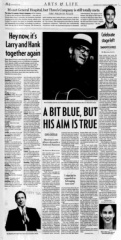National Post, November 2, 2010: Difference between revisions
m (resize image) |
(add transcribed text) |
||
| Line 11: | Line 11: | ||
---- | ---- | ||
{{Bibliography text}} | {{Bibliography text}} | ||
' | Elvis Costello's home sounds like a mini-war zone. | ||
Over the phone from his West Vancouver residence, where he and his wife, Canadian jazz chanteuse Diana Krall, spend a good part of their time, you can hear their four-year-old-twins, Dexter Henry Lorcan and Frank Harlan James, running amok in the background. | |||
"Yeah, I have to go play referee in a minute," Costello says with a chuckle. | |||
If the ruckus at home gives Costello a reason to smile, an entirely different - and much more serious - kind of turmoil makes up the core theme of his latest album, ''National Ransom'', released today. | |||
The album cover, designed by famed cartoonist/illustrator Tony Millionaire, is striking: a wolf dressed in business attire, money flying out of its attache case, catching fire as it floats through the air. The scene, with oil rigs, fighter jets and the "all-seeing eye" pyramid of the US dollar in the background, is framed within a bill design that emulates various international currencies. | |||
The message is clear: The wolf - an embodiment of the big banks, multinational corporations and greedy politicians profiting from bailouts and handouts - isn't at the door anymore: It has pillaged and plundered your home, and now it is making a run for it. | |||
On ''National Ransom,'' Costello paints 16 vignettes of the times we live in - financial crisis, war, global uncertainty - stamped with the echoes of crises past and their musical cornerstones. He does so with a poignant spirit, sonically touching upon the swinging 1920s, the dust-bowl twang of the Great Depression, the gospel and soul of the inner city, and the rock'n'roll-inflected strife of modern times, and through the characters, real and imagined, living within the stories in his songs. | |||
"It's not to say that it's not circumstances that people haven't confronted before," Costello says of the concept behind ''National Ransom''. "This particular 'ransom' has been called for on a number of occasions, but we're living through it now. | |||
"The characters in some of the songs are walking through the times when these sorts of conditions applied in the past," Costello adds,"and I've borrowed some of the musical structures from there. I'm not trying to replicate songs from those eras exactly. I'm using hints of that music to bring these songs and characters to life the best I can. And they're new songs: They're being played in the present moment with the immediacy of new songs." | |||
{{cx}} | {{cx}} | ||
Revision as of 20:39, 24 April 2019
|


